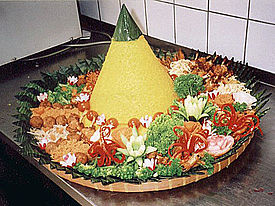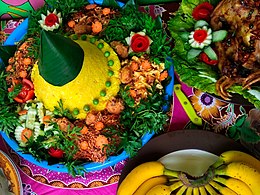Tumpeng
 Tumpeng: the cone-shaped rice surrounded by assorted Indonesian dishes. | |
| Course | Main course |
|---|---|
| Place of origin | Indonesia[1] |
| Region or state | Java, Nationwide |
| Associated cuisine | Indonesia |
| Serving temperature | Hot or room temperature |
| Main ingredients | Cone-shaped rice, urab (vegetables in shredded coconut), fried chicken, fried tempeh, boiled marble egg, shredded omelette, salted anchovy and peanuts |
| Variations | Tumpeng robyong, tumpeng putih, tumpeng nasi uduk, tumpeng slametan (nasi kuning) |
 |
| This article is part of the series on |
| Indonesian cuisine Masakan Indonesia |
|---|
|
|
Tumpeng (Javanese: ꦠꦸꦩ꧀ꦥꦼꦁ; Balinese: ᬢᬸᬫ᭄ᬧᭂᬂ) is an Indonesian cone-shaped rice dish with side dishes of vegetables and meat originating from Javanese cuisine of Indonesia. Traditionally featured in the slamatan ceremony, the rice is made by using a cone-shaped woven bamboo container. The rice itself may be plain steamed rice, uduk rice (cooked with coconut milk), or yellow rice (uduk rice colored with kunyit (turmeric)).[1]
The rice cone is set out on the tampah (rounded woven bamboo container), preliminary covered with a banana leaf, and surrounded by assorted Indonesian dishes. In 2013, the Indonesian Ministry of Tourism and Creative Economy promoted tumpeng as one of 30 Indonesian culinary icons[2] and declared it Indonesia's official national dish in 2014, describing it as "the dish that binds the diversity of Indonesian various culinary traditions."[3]
Tumpeng is a symbol of gratitude.[1] According to folklore in Java and Bali, the cone-shaped tumpeng is a symbol of life and of the glory of God as the creator of nature, and the side dishes and vegetables represent the life and harmony of nature. Usually tumpeng is served with spinach, which is a traditional symbol of prosperity in Javanese agricultural society.[4]
Surrounding dishes
[edit]
The cone-shaped rice is surrounded by assorted Indonesian dishes, such as urap vegetables, ayam goreng (fried chicken), ayam bakar (grilled chicken), empal gepuk (sweet and spicy fried beef), abon sapi (beef floss), semur (beef stew in sweet soy sauce), teri kacang (anchovy with peanuts), fried prawn, telur pindang (boiled marble egg), shredded omelette, tempe orek (sweet and dry fried tempeh), perkedel kentang (mashed potato fritters), perkedel jagung (corn fritters), sambal goreng ati (liver in chilli sauce), sliced cucumbers and many other things.[5]
Variations
[edit]This section needs additional citations for verification. (February 2021) |

There are several variants of tumpeng, differentiated according to the ceremonies.[1]
- Tumpeng Robyong — This kind of tumpeng usually served in the traditional Javanese siraman (bridal shower) ceremony. Tumpeng is placed on bakul bamboo rice container; egg, shrimp paste, shallots and red chilli are placed on top.
- Tumpeng Nujuh Bulan — This kind of tumpeng is served in the seventh month of pregnancy (prenatal ceremony). Tumpeng is made of plain white rice. A main tumpeng is surrounded by six smaller tumpeng; all tumpengs are erected on tampah covered with banana leaf.
- Tumpeng Pungkur — Used in the ceremony for the death of a virgin or unmarried male or female. It is made from white rice surrounded only with vegetables dishes. The tumpeng later must be cut vertical into two parts evenly and placed one against another.
- Tumpeng Putih — White tumpeng, uses white rice since white symbolizes holiness in Javanese culture. This kind of tumpeng is employed in sacred ceremonies.
- Tumpeng Nasi Kuning — Yellow tumpeng: The color yellow represents gold, wealth, abundance, and high morals. This kind of tumpeng is employed in cheerful and happy festivities and celebrations, such as celebration of birth, engagement, marriage, Eid, Christmas, etc.
- Tumpeng Nasi Uduk (also called tumpeng tasyakuran) — The uduk rice (rice cooked in coconut milk) employed in the Maulud Nabi ceremony: celebrating the birthday of Muhammad.
- Tumpeng Seremonial/Modifikasi — This contemporary tumpeng is relatively more open for modifications and adaptations. It depends on the discretion, taste, and request of the host.
- Mini Tumpeng — This kind of small rice cone which is usually served for 1 person like a rice box, unique is a mini cone served in a unique place with a transparent mica lid, so food can be seen from the outside.
- Character Tumpeng Rice — This is usually used for birthdays or conventions, and young children and pop culture fans love it because of its unique shape, but the unique shape can also be used like a cone for a birthday celebration or fan conventions.
Contemporary tradition
[edit]
Today, most Indonesians serve tumpeng as a dish to celebrate a special occasion, such as a birthday party, arisan, family or neighborhood gathering, farewell party, celebrations, recitals, and many other joyous events.[6] Because of its festive and celebration value, up until now tumpeng sometimes seen as an Indonesian counterpart of birthday cake.[7]
In 2009 Garuda Indonesia started offering Mini Nasi Tumpeng Nusantara as part of its new concept to highlight Indonesia's hospitality.[8]
Tumpeng is offered in Indonesian restaurants abroad, such as in neighboring Singapore[9] and the Netherlands[10] as well as in Kelantan.[11]
The building of Suharto's Purna Bhakti Pertiwi Museum in Taman Mini Indonesia Indah, Jakarta, took shape of tumpeng.[12]
See also
[edit]References
[edit]- ^ a b c d Riyan (8 April 2013). "The Rice Cone or "Nasi Tumpeng", Traditional Rice Cone, the Pride of Indonesia". Describe Indonesia. Retrieved 11 June 2014.
- ^ "Tumpeng, Ikon Kuliner Indonesia" (in Indonesian). Travel Kompas.com. 22 April 2013. Retrieved 11 June 2014.
- ^ Nadya Natahadibrata (10 February 2014). "Celebratory rice cone dish to represent the archipelago". The Jakarta Post. Retrieved 2014-07-09.
- ^ Folklore, Javanese. "What Tumpeng Means for us Indonesian". www.indonesiapa.com. Indonesiapa Webzine. Archived from the original on 14 July 2014. Retrieved 12 July 2014.
- ^ "Menyiapkan Lauk Tumpeng". detikfood (in Indonesian). Retrieved 2018-01-25.
- ^ simple, trik. "Tumpeng, Special Dish For Special Ceremony". triksimple.com. Retrieved 20 July 2014.
- ^ McAuliffe, Annelise (2 June 2014). "A Look at Birthday Cakes from Around the World". Honest Cooking, Gastronomy and Travel. Retrieved 20 July 2014.
- ^ "Garuda Indonesia Experience - Penerbangan yang Mencerminkan Indonesia" (in Indonesian). garudamagazine.com. Retrieved 11 June 2014.
- ^ "Yellow Rice Singapore – Nasi Tumpeng". IndoChili Indonesian Restaurant.
- ^ "Dewi Sri Restaurant". Rotterdam, The Netherlands: Tripadvisor.
- ^ "Nasi Tumpang di Kelantan". YouTube. Kota Bharu, Kelantan, Malaysia.
- ^ "Museum Purna Bhakti Pertiwi". touristlink. Retrieved 11 June 2014.
External links
[edit]- (in Indonesian) Resep Nasi Tumpeng
- (in English) Philosophical meaning of tumpeng

